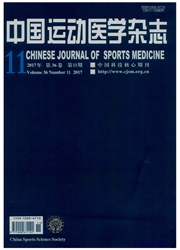

 中文摘要:
中文摘要:
目的:探讨大鼠在安静、运动、疲劳、恢复等不同状态下纹状体神经元电活动变化特征与运动能力的关系。方法:采用金属微电极植入和在体电生理记录技术,连续动态观察一次性力竭运动过程中大鼠纹状体神经元局部场电位(LFPs)活动.并对大鼠运动能力进行观察。结果:一次性力竭运动过程中大鼠纹状体神经元LFPs活动呈动态变化规律。主要表现为:与安静状态相比,运动过程中放电频率逐渐升高、幅度逐渐降低,力竭后逐渐降低至安静水平。结论:在力竭运动过程中,纹状体LFPs活动的动态变化具有明显的阶段性特征.该脑区LFPs电活动的改变与运动疲劳有关。在运动初期纹状体主要是通过直接通路参与皮层运动的调控.而在运动后期,则主要通过间接通路发挥作用。提示:两条通路的平衡失调是导致大鼠运动能力下降的重要原因之一。
 英文摘要:
英文摘要:
Objective To investigate the relation of dynamic changes in local field potentials(LFPs) in rat striatum at rest, during exercise, fatigue,and recovery process to the exercise performance of rats. Methods The pre-implanted electrode was used to observe the dynamic changes of LFPs in rat striatum in vivo during exhausting exercise, and the exercise performance of the rats was also recorded. Results The frequency of LFPs during exercise increased gradually,while the amplitude decreased gradually and reached the baseline after exhaustion as compared with at rest. Conclusion During exhaustive exercise, dynamic changes of LFPs in striatum are correlated with the exercise-induced fatigue. The cortex activity during the early period is mainly modulated by the direct pathway, while, by the indirect pathway during the later period. Results indicated that the imbalance between the direct pathway and indirect pathway might be one of the most important reasons that cause the decrease in the exercise performance.
 同期刊论文项目
同期刊论文项目
 同项目期刊论文
同项目期刊论文
 Increased extracellular dopamine and 5-hydroxytryptamine levels contribute to enhanced subthalamic n
Increased extracellular dopamine and 5-hydroxytryptamine levels contribute to enhanced subthalamic n Applying H-1 NMR Spectroscopy to Detect Changes in the Urinary Metabolite Levels of Chinese Half-Pip
Applying H-1 NMR Spectroscopy to Detect Changes in the Urinary Metabolite Levels of Chinese Half-Pip 期刊信息
期刊信息
